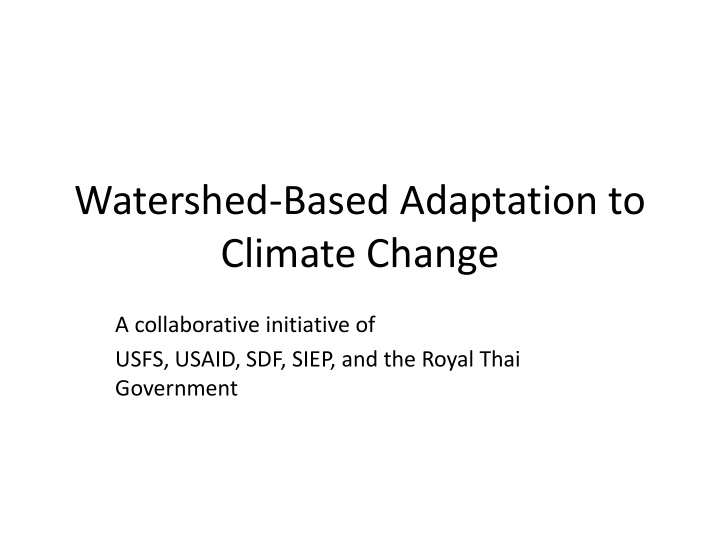



Watershed-Based Adaptation to Climate Change A collaborative initiative of USFS, USAID, SDF, SIEP, and the Royal Thai Government
Outline • Project objectives and rationale • Project partners • Project deliverables • Focus on guidance for watershed VAA • Roundtable inputs on guidance
WACC Objectives • Develop a model VAA for SE Asia watersheds • Test watershed VAA in SIEP / Petchaburi
WACC Objectives • Develop a model VAA for SE Asia watersheds • Test watershed VAA in SIEP / Petchaburi • Build capacity to undertake VAAs in watersheds • Inform decisions about watershed development and conservation in response to climate change
WACC Rationale • CC impacts on water flows a principal concern focus on watersheds • Integrated VAAs complex, but needed • Integrated VAAs can assess concerns of multiple stakeholders • Merge best from existing VAAs • Good VAA prerequisite for climate finance Source: www.waterprotection.ca/download/watershedc.jpg
WACC Partners Thai Colleagues USG • NRCT – Project management, • USAID ADAPT – project coordination and funding design, support to NRCT, and • RU – climate downscaling, Cambodia & Vietnam WEAP modeling • USFS – technical support • SDF – stakeholder consultations • SIEP – land cover mapping, biodiversity assessments • LDD – land use and land suitability mapping
WACC Conceptual Design Evidence Develop & Test & inputs watershed VAA Model Prioritized adaptation watershed VAA strategies Climate $ proposal to Guidance for implement strategies watershed VAA M&E Plan Implementation & monitoring Replication & scaling
WACC Deliverables • VAA for Petchaburi watershed • Guidance on watershed-based VAA approach • International Conference • Interpretive program / exhibits at SIEP • Outline for training program
WACC Guidance – USFS Inputs Management modifies tends to decrease Stressors Adaptive capacity tends to increase tends to depends on Buffers modifies increase tends to depends on decrease Exposure Intrinsic Composite to climatic Values Vulnerability sensitivity sensitivity depends on controls results in affected by changes Values × Exposure × Sensitivity = Vulnerability — “ ” “ ”
WACC Guidance – Other Inputs ADB CEP Framework SDF Framework • • Socioeconomic context Background Information (socio-economic context, bio- • Current risk & vulnerability physical characteristics, • Formulate plausible future(s) resource use, current • Future risks & vulnerabilities concerns, etc.) • Adaptation strategies • ID factors affecting future • ID options to implement • CC vulnerabilities (physical, strategies social, infrastructure, etc.) • Adaptation options analysis Some Common Elements: Top-down + bottom-up analyses shared understanding adaptation options cost & sustainability analysis
WACC Guidance – Possible Structure • Overview & Rationale (value of regional framework) • Framework / Stepwise explanation of approach • SIEP Case Study • Other case studies from region
WACC Guidance – Roundtable Inputs • How can guidance best incorporate evidence from existing VAAs in the region? • Who should it target?
Recommend
More recommend